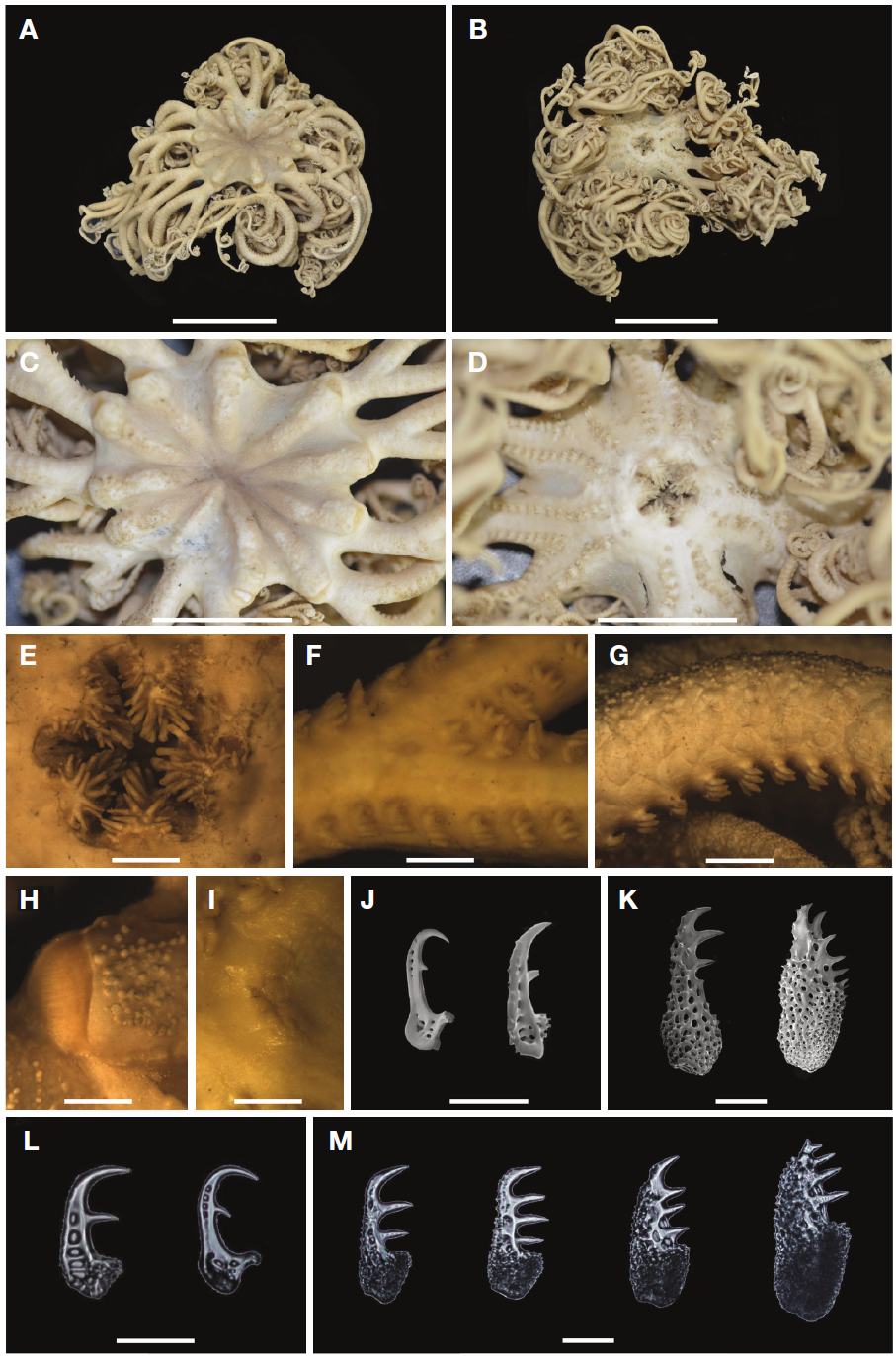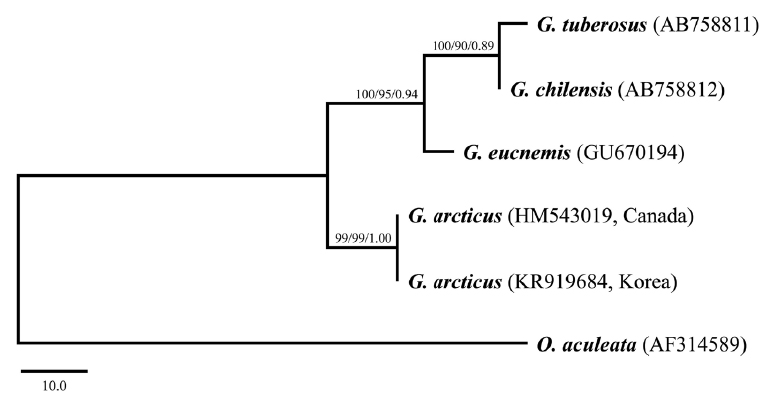Family Gorgonocephalidae, comprising 34 genera, is the largest of three families belonging to order Euryalida (Stöhr, 2015), and its four genera (Astroboa, Astrocladus, Astrodendrum, and Gorgonocephalus) have been reported in Korean fauna (Shin and Rho, 1996; Shin, 2013). Species of this family have very branched five arms and have rings of little hook-like spines forming bands around the branches of each arm. Almost all Gorgonocephalus species are exclusively distributed in deep water and are of worldwide distribution (Piepenburg, 2000). This genus has special features such as the presence of arm spines before the first arm fork of arms, disk and arm covered with small stumps or tubercles, disk often naked interradially (Baker, 1980), and the presence of a row of marginal plates on the interbrachial outer margin (Matsumoto, 1917). A family-level revision of order Euryalida based on sequences from mitochondrial genes (16S rRNA and cytochrome c oxidase I [COI]) and a nuclear gene (18S rRNA) from 83 euryalid ophiuroids including G. chilensis, G. eucnemis, G. pustulatum, and G. tuberosus was investigated (Okanishi and Fujita, 2013). Only three (G. dolichodactylus, G. eucnemis, and G. tuberosus) of 10 Gorgonocephalus species have been reported in Korea based on their morphology (Shin, 2013; Kim and Shin, 2015).
Some basket stars were collected from Gonghyeonjin and Daejin, Gangwon-do in the East Sea, Korea at a depth of 250-300 m by fishing nets on November 2013 and August 2014. The specimens were preserved in 95% ethyl alcohol and identified on the basis of morphological characteristics and molecular analyses. The important morphological characteristics were photographed using a digital camera (Nikon D7000, Tokyo, Japan), stereo-microscope (Nikon SMZ 1000), and scanning electron microscope (JEOL JSM-6510, Tokyo, Japan). The sequences of mitochondrial cytochrome c oxidase I (mt-COI) gene were analyzed with newly intended primers (F-TGRGCYGGVACMRYDGGAACHGC and R-GGRTCHCCKCCHC CHGWDGGRTC) for the accurate molecular identification of Korean Gorgonocephalus species. DNA was extracted using DNeasy Tissue and Blood Kits (Qiagen, Hilden, Germany), and PCR and phylogenetic analyses were conducted according to Lee and Shin (2011) with minor revision. The phylogenetic trees were inferred from their alignment sequences by maximum parsimony (MP), maximum likelihood (ML), and Bayesian inference (BI) methods. They were identified as Gorgonocephalus arcticus Leach, 1819, which is reported for the first time in Korea. These specimens are deposited in the Marine Echinoderm Resource Bank of Korea (MERBK), Sahmyook University, Seoul, Korea.
Class Ophiuroidea Gray, 1840
Order Euryalida Lamarck, 1816
Family Gorgonocephalidae Ljungman, 1867
Genus Gorgonocephalus Leach, 1815
1*Gorgonocephalus arcticus Leach, 1819 (Fig. 1)
[Fig. 1.] Gorgonocephalus arcticus. A, C, Dorsal view; B, D, Ventral view; E, Oral part; F, Ventral side of arm; G, Lateral side of arm; H, Distal part of radial shield; I, Madreporite; J, K, Arm spines under scanning electron microscope; L, M, Arm spines under light microscope. Scale bars: A, B=2.5 cm, C, D=1.4 cm, E-I=3 mm, J-M=50 μm.
Astrophyton agassizi: Lyman, 1865: 186.
Gorgonocephalus agassizii: Lyman, 1882: 264.
Gorgonocephalus arcticus: Döderlein, 1911: 103; Koehler, 1924: 231; Mortensen, 1933: 9; D’yakonov, 1954: 27; Smirnov and Smirnov, 1990: 446; 1994: 161; Anisimova and Cochrane, 2003: 126.
Material examined. Korea: 1 specimen, Gonghyeonjin Port, Gonghyeonjin-ri, Jugwang-myeon, Goseong-gun, Gangwon-do, 12 Nov 2013, at 250 m depth by fishing net; 1 specimen, Daejin Port, Hyeonnae-myeon, Goseong-gun, Gangwon-do, 29 Aug 2014, at 300 m depth by fishing net.
Description. Disk with thin plates, covered with many small granules, with a row of marginal plates on interbrachial outer margin (Fig. 1A, B). Especially, radial shields and dorsal side of arms densely covered with granules of various sizes (Fig. 1C, H). Radial shields have different lengths and widely concave features tapering towards center of disk. One madreporite left a trace on corner of ventral side of disk (Fig. 1I). Three or four arm spines exist between arm segments on ventral side of arm. Arm spine short, cylindrical, with many small pores, half of corresponding arm segment (Fig. 1F, G), becoming hooks with two or three pointed tips near end of arm (Fig. 1J-M). Oral parts composed of sharp spiniform teeth (Fig. 1D, E).
Size. R=2.5 cm, r=1.5 cm, R/r=1.6.
Color. Color is yellow ocher in life and is light brown in alcohol.
Distribution. Korea (East Sea), Siberian East Coast, Arctic Ocean (Greenland, Spitzbergen, Barents Sea, White Sea, Kara Sea, Franz Josef Land), North America, Norway, Gulf of Mexico.
Remarks. This northern basket star is an endemic arctic species usually distributed in the cold boreal zone around the northwest North Atlantic Ocean (Piepenburg, 2000), and is characterized having a smooth and thick body, distinctly upwelled disk, and acute spiniform teeth.
Molecular analysis. A total of 569 base pairs (bp) of mt-COI DNA were obtained from Korean G. arcticus (GenBank accession number: KR919684), and perfectly correspond to G. arcticus sequence data obtained from NCBI (GenBank HM543019, Canada). There were partial sequence gaps comparing to each sequence of other Gorgonocephalus species obtained from NCBI: difference as 36 bp from G. tuberosus (GenBank AB758811), difference as 32 bp from G. chilensis (GenBank AB758812), and difference as 25 bp from G. eucnemis (GenBank GU670194) (Table 1). We appointed Ophiopholis aculeata as the outgroup, and analyzed the sequence of G. arcticus from Korea with those of G. acrticus, G. chilensis, G. eucnemis, and G. tuberosus obtained from NCBI. The phylogenetic trees inferred from their alignment sequences by the MP, ML, and BI methods are very similar to each other, with only minor differences (Fig. 2). All trees confirm that the Korean species is clearly different from G. tuberosus, G. eucnemis, and G. chiliensis, and Korean G. arcticus data are coincident with G. arcticus of NCBI data of family Gorgonocephalidae.







